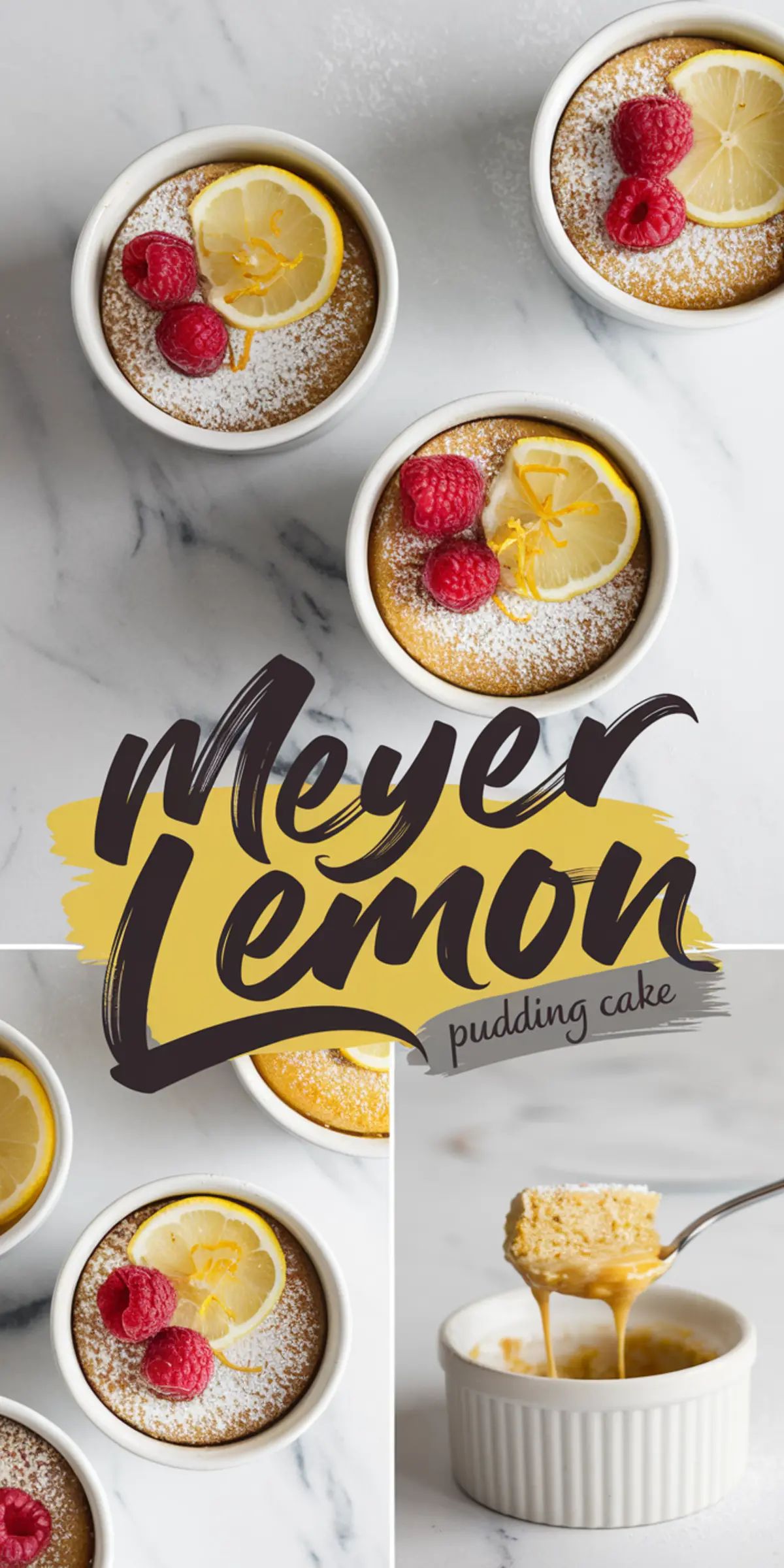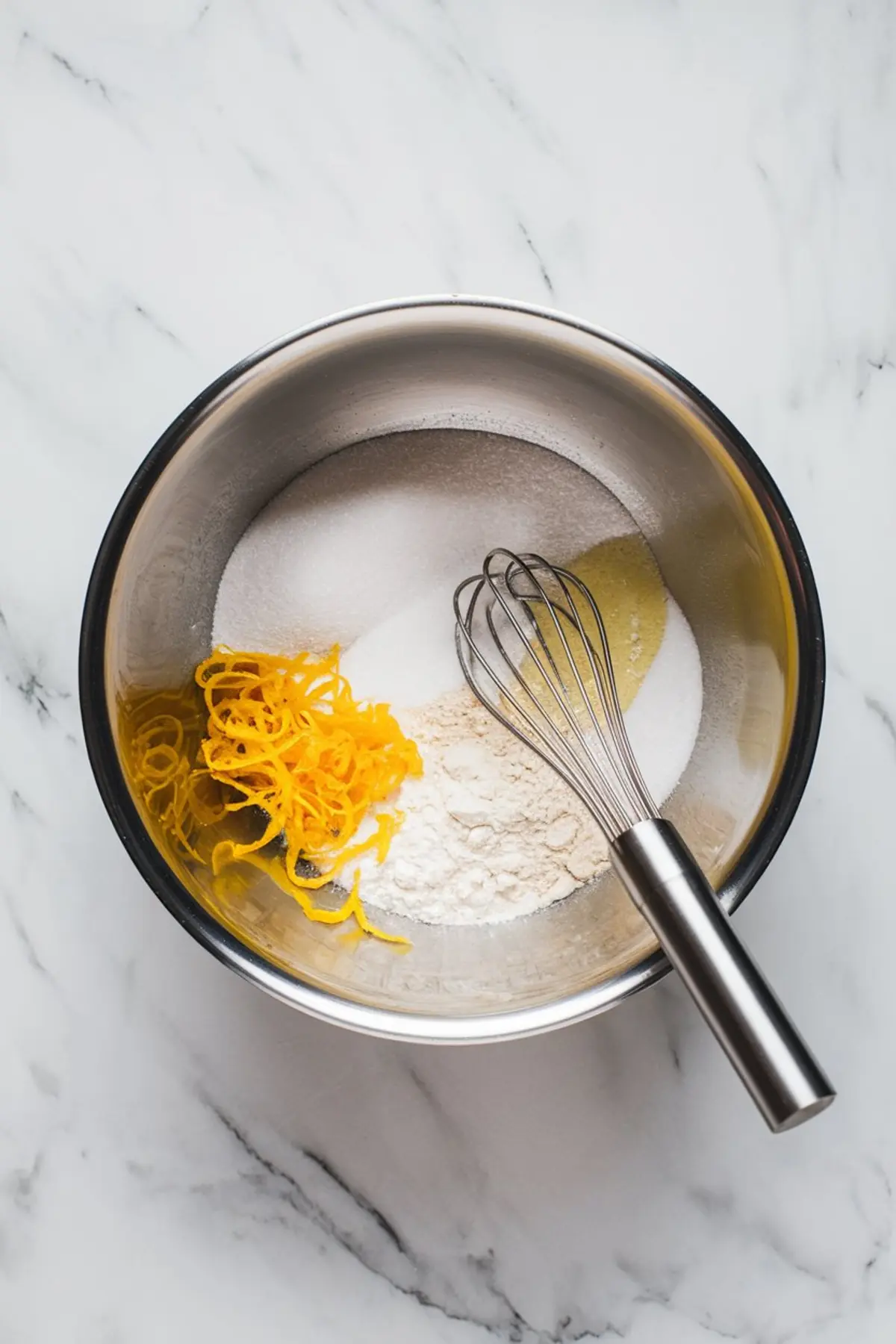Bright, soft, and quietly confident, this Meyer lemon pudding cake shows off without trying. You’ll learn how to bake a one-batter dessert that gently splits into a fluffy sponge top and a creamy pudding base. It’s a bit of kitchen magic, no trickery required.
Meyer lemons add a subtle sweetness that makes this cake different. It doesn’t slap you with tartness. It sings a smoother, more mellow note.
If you’re looking for something simple to bake, but still elegant and satisfying, this is that recipe. You don’t need fancy tools. Just a whisk, a couple of bowls, and a quiet hour. I’ve made this cake for birthdays, snow days, and just-because days. It always delivers.

Meyer Lemon vs. Regular Lemon: Why the Fruit Matters
There’s a reason this cake starts with Meyer lemons. They aren’t aggressive. They’re floral and tender. Somewhere between a lemon and a mandarin, they bring a balance that keeps the pudding layer from tasting sour.
You can use regular lemons, but you’ll want to adjust the juice and sugar. I’ve done it both ways, and the Meyer version always feels a little more composed. A little more thoughtful.
This dessert doesn’t demand too much from the fruit. It just lets it speak clearly.
A Single Batter, Two Layers: How the Texture Works
This cake forms two distinct layers from one bowl of batter. That’s the part that always gets people. The top puffs into a light sponge that catches the powdered sugar like snow. Underneath, a soft pudding waits, silky and warm.
The trick is the egg whites. When you fold them in—gently, don’t rush—the batter holds enough air to lift the sponge. Meanwhile, the liquid settles low, cooking slowly into a creamy base.
I learned early not to overbeat the whites or stir too hard. It’s not a cake you wrestle. You guide it.
Ingredients That Matter More Than You Think

Granulated sugar brings sweetness in two stages. Half goes into the base, the other half strengthens the meringue.
Lemon zest doesn’t just smell good. It carries the oils that wake up the whole dish.
Milk should be room temperature. Cold milk slows down how the batter sets and can make the sponge collapse.
Butter gives the pudding richness, but don’t drown it. Three tablespoons is the line I don’t cross.
Eggs are the structure. Use fresh ones. If you’ve ever made this cake with older eggs, you’ll taste the difference. I have. It matters.
Step by Step: The Method That Never Fails Me
I preheat the oven first and line up the ramekins in a deep baking dish. The water bath helps bake the cake evenly, keeping the custard tender and smooth.
In one bowl, I whisk sugar, zest, flour, salt, melted butter, lemon juice, and milk. That becomes the base. It looks thin, but don’t worry—it thickens as it bakes.

Egg yolks go straight into the batter. The whites, though, get their own moment. I beat them until soft peaks form, then add sugar slowly. They turn glossy and strong.
Folding the whites into the batter takes patience. I start with a third, just to lighten things. The rest goes in carefully, with long, slow turns of the spatula.

Baking takes 35 to 40 minutes. The tops will look golden and puffed, but if you jiggle the ramekin gently, you should still see the pudding wiggle underneath.
I leave them in the water bath for 15 minutes after baking, then transfer to a rack to cool a bit longer. Warm is best. Room temperature is good too. Cold? Less lovely.

Serving Suggestions for Meyer Lemon Pudding Cake
I dust the tops with powdered sugar right before serving. If I have fresh raspberries, I scatter a few around the plate. Their tartness balances the pudding’s mellow tone.
You can also add a thin lemon slice, but don’t overdo it. This cake doesn’t need showy garnish. Its charm is quiet.
Sometimes I serve it straight from the ramekin with a small spoon. Other times, I run a thin knife around the edge and plate it carefully. Either way, it’s meant to be soft and spoonable.
Storage Tips and What to Expect the Next Day
You can refrigerate these, covered, for up to two days. The sponge will lose some height but the pudding thickens nicely. I’ve eaten it cold from the fridge and still loved every bite.
If you want to reheat, use a low oven. Don’t microwave it. That turns the texture rubbery.
Honestly, this dessert is best the day it’s baked. But I’ve never regretted leftovers.
My Quiet Tradition: Why I Return to This Cake
There’s something comforting about how this cake always works. It’s the kind of dessert I reach for when I need something steady.
The first time I made it, I used regular lemons and forgot the cream of tartar. It still baked beautifully. Over time, I’ve made little changes—less sugar, more zest, a splash more juice. The structure always holds.
And every time I pull those ramekins from the oven, something about the golden tops and the soft wobble below tells me: this is enough.
This cake doesn’t ask you to impress anyone. It just shows up, simple and good.
Save and Share: Bring More Lemon to Your Table
Save this Meyer Lemon Pudding Cake to your Lemon Dessert Ideas board so it’s easy to find next time.
If you try it, I’d love to hear how it turned out. Did you use Meyer lemons or regular ones? Did you serve it warm or chilled? Leave a comment—I read every one.
We’re building a little kitchen table here, and your stories make it warmer.
Meyer Lemon Pudding Cake

A light, tangy dessert made from one simple batter that separates into a soft sponge cake on top and a smooth lemon pudding underneath. Meyer lemons add a subtle sweetness that balances the citrus flavor beautifully. Serve warm or at room temperature for a comforting, bright finish to any meal.
Ingredients
- 1/2 cup (100g) granulated sugar, divided
- 1 tablespoon lemon zest (from about 2 Meyer lemons)
- 1/3 cup (40g) all-purpose flour
- 1/4 teaspoon salt
- 3 tablespoons unsalted butter, melted
- 1/3 cup freshly squeezed Meyer lemon juice (about 2–3 lemons)
- 1 cup whole milk, room temperature
- 3 large eggs, separated
- 1/4 teaspoon cream of tartar (optional, for extra meringue stability)
- Powdered sugar, for dusting
- Fresh raspberries and lemon slices, for garnish (optional)
Instructions
- PREHEAT AND PREPARE: Preheat the oven to 325°F (160°C). Lightly butter or spray 4 to 6 ramekins and place them in a deep baking dish. Set aside for a water bath that will help bake the pudding evenly.
- MIX THE BASE: In a large bowl, whisk together 1/4 cup of the sugar, lemon zest, flour, and salt. Add the melted butter, Meyer lemon juice, and milk. Whisk until smooth and well blended.
- SEPARATE AND BEAT THE EGGS: Separate the egg yolks and whites. Whisk the yolks into the lemon mixture until fully combined. In a separate clean bowl, beat the egg whites with cream of tartar (if using) until soft peaks form. Gradually add the remaining 1/4 cup sugar and continue beating until the egg whites are glossy and form stiff peaks.
- FOLD GENTLY: Fold one-third of the egg whites into the lemon batter using a spatula to lighten the mixture. Gently fold in the remaining whites in two more additions, being careful not to deflate the batter.
- BAKE IN A WATER BATH: Divide the batter evenly among the prepared ramekins. Carefully pour hot water into the baking dish around the ramekins until it reaches halfway up the sides. Bake for 35 to 40 minutes, or until the tops are golden, puffed, and just set with a slight jiggle beneath the surface.
- COOL AND SERVE: Remove the baking dish from the oven and let the ramekins cool in the water bath for 15 minutes. Transfer the ramekins to a wire rack and cool for another 15 to 20 minutes. Dust with powdered sugar and garnish with raspberries and lemon slices if desired before serving.
Notes
For the best texture, serve the cakes slightly warm or at room temperature. The pudding layer will firm up slightly as it cools. Meyer lemons are preferred for their sweeter flavor, but regular lemons can be substituted—just reduce the juice slightly or increase the sugar to balance the tartness.

